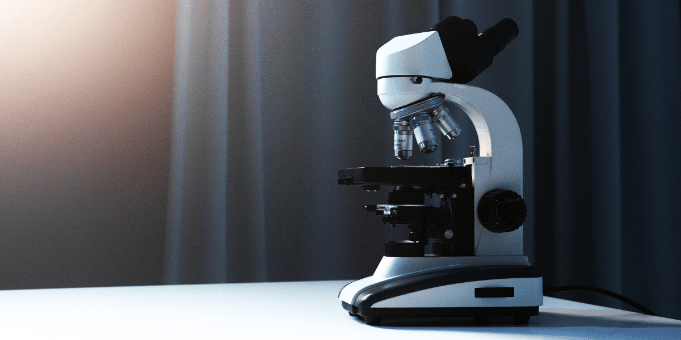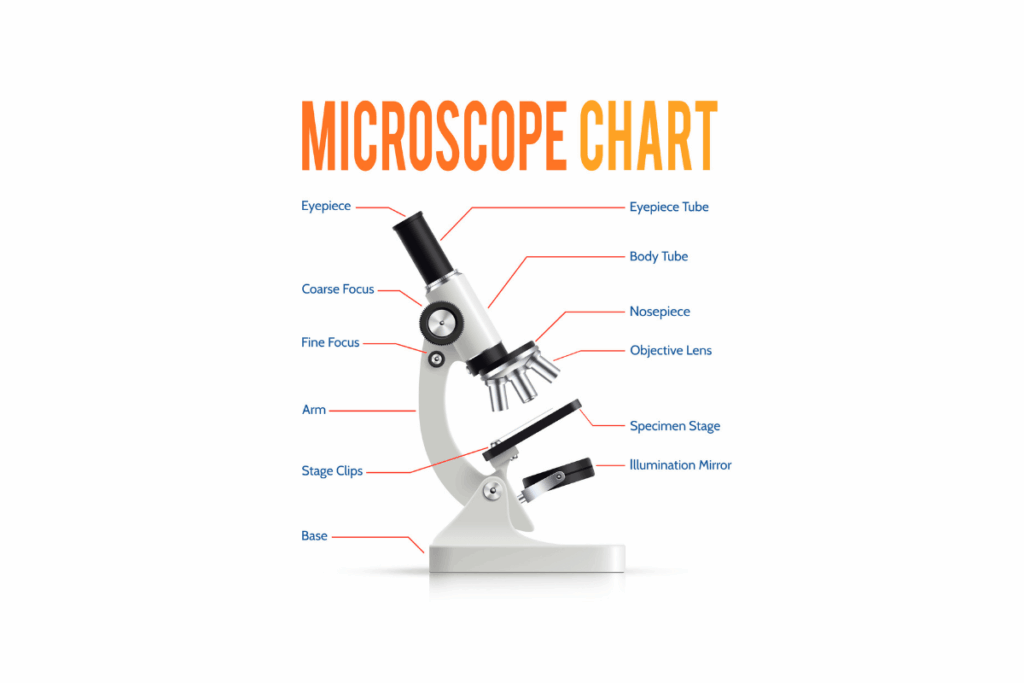
Quick Summary
Table of Contents
A microscope is a vital optical instrument used to magnify tiny objects or organisms, making them visible in detail. The microscope diagram helps learners visually understand its key parts- such as the eyepiece, objective lenses, stage, condenser, and light source- and how each component contributes to clear and accurate magnification. This guide simplifies the complex structure of microscopes and is ideal for students and science enthusiasts.

A microscope is a scientific instrument used to magnify small objects, such as cells and microorganisms, making them visible for detailed study. It works by using specialized lenses with varying magnification powers, allowing scientists to observe objects in fine detail.
Microscopes consist of structural components, such as the base, arm, and head- providing support -and optical parts that magnify and display images. Advanced models may also include electronic features for enhanced viewing. There are various types of microscopes, including light, dark-field, phase contrast, electron, and fluorescent, each designed to reveal specific details, from cellular structures to distinguishing between plant, animal, and bacterial cells.
Magnification is measured by how many times larger the image appears compared to the object, typically expressed in “times” like 10x (ten times larger). Resolution refers to the clarity and detail an instrument can reveal. The first compound microscope was invented by Zacharias Janssen in 1590. Today, microscopes are specialized tools used for studying everything from plant cells to metals.
Microscopes are made up of three main structural parts: the head, arm, and base.

Microscopes use various optical parts to magnify and display clear images of specimens. Here’s an overview of each component:
These optical components work together to provide clear, magnified views of specimens, essential for accurate observation and analysis.
Microscopes act like superpowered magnifying glasses, letting us see objects invisible to the naked eye. We place a thin slice of our sample, like a cell or insect wing, on a slide. The light then travels down through the microscope, focusing on the specimens with the help of a lens called a condenser. Another lens, the objective, bends the light rays, creating an initial magnified image. This image is then further enlarged by the eyepiece, acting like a second magnifying glass. By peering through the eyepiece, we can finally observe the greatly magnified world, revealing hidden details of the tiny specimens.
Invest in understanding the microscope diagram, and unlock the wonders of the microscopic world!
Drawing a microscope diagram is an excellent way to reinforce your understanding of its components and structure. Follow these step-by-step instructions to create a simple, clear microscope drawing.
Step 1: Starting with the Eyepiece
Begin by drawing the top part of the microscope: the eyepiece. Make a small, rounded square shape to represent it. From the eyepiece, draw two straight vertical lines downward. Below these lines, add two thin rectangular shapes as the eyepiece base. Near the base, draw some circles to represent adjustment knobs. This completes step one.
Step 2: Adding Lenses
Next, extend more vertical lines downward to form the lens section. Draw several diagonal shapes side by side, connected by a rounded line on the side, outlining the nosepiece area where lenses attach. Inside this section, sketch several thin rectangles with rounded ends to depict the objective lenses. Finish this step by adding a curvy line on the right side to complete the lens body.
Step 3: Arm and Stage
Now, draw the arm, the curved structure that holds the microscope body. Starting from the top knob, sketch a curved line that extends downward. Then, draw the stage- the flat platform where specimens are placed, using thin rectangular shapes. Step three is complete with these structural elements.
Step 4: Finishing the Base
Draw a rounded shape beneath the arm and stage to form the base of the microscope, which provides stability. Add small circles to indicate screws or textured parts. Draw a small mirrored shape on a hinge at the base to represent the light source or reflector. Complete this step by adding rectangular and rounded shapes near the base to give it structural detail.
Step 5: Adding Details
Enhance your drawing by adding texture using straight and curved lines on different parts, such as the arm, lenses, and base. Feel free to add creative elements around the microscope, such as other scientific tools or background museum or lab items, giving context to your drawing.
Step 6: Adding Color
Finally, bring your microscope diagram to life with color. Use light greys, blues, or any shades you prefer to highlight various parts. Coloring not only makes the diagram visually appealing but also helps in memorizing the parts better. What colors will you choose?
A compound microscope is an optical instrument used to magnify small objects, making them visible for examination and analysis. It typically consists of multiple lenses and is primarily used in fields like biology, medical science, and materials science. Here’s a breakdown of its key components and features:
Key Components:
Applications:
| Advantages | Disadvantages |
|---|---|
| Magnifies objects up to 3000x, revealing hidden details | High magnification can cause blurriness |
| Broader field of view compared to simpler microscopes | Specimen preparation can be time-consuming |
| Versatile for live or preserved specimens | Only thin specimen slices can be clearly focused at once |
| Affordable compared to advanced microscopes | Requires practice for optimal use |

A binocular microscope uses two eyepieces to view specimens, allowing stereoscopic or 3D vision. Unlike monocular microscopes with one eyepiece, the binocular design provides a more natural, comfortable experience by reducing eye strain and improving depth perception.
Key Components:
A microscope diagram for Class 9 typically illustrates the essential parts of a microscope, which is used to magnify small objects. Key components include:
In a Class 9 microscope diagram, these components are labeled to help students understand the function of each part for proper use and operation.
From its early invention to today’s advanced models, microscopes have evolved into essential tools for medical diagnostics, biological research, materials science, and education. Understanding the parts, how it works, and the different types prepares students and researchers to explore and appreciate the intricate details underlying life and matter. Mastery of microscope diagrams and practical drawing enhances comprehension and engagement. As technology advances, microscopes will continue to unlock deeper insights into the microscopic realm and fuel scientific discovery.
Read More:
The microscope’s optical components include:
1. Eyepiece (ocular)
2. Eyepiece tube (eyepiece holder)
3. Objective lenses
4. Nose piece
5. Coarse and Fine adjustment knobs
6. Stage
7. Aperture
8. Microscopic illuminator
Antoni van Leeuwenhoek (1632-1723) is the father of microscopy.
A microscope is used to magnify tiny objects that cannot be seen by the naked eye. It helps scientists examine cells, bacteria, and other microorganisms, enabling research in biology, medicine, and material science. Microscopes are central in studying disease, developing treatments, and quality control in various industries.
A compound microscope magnifies using two lenses to compound (multiply) the level of magnification. The first is the objective lens with magnification options like 4x, 10x, 40x, or 100x. The second lens is the eyepiece lens.
A compound microscope employs two convex lenses for magnification. The ocular lens is near the eye, and the other is the objective lens.
Microscope diagrams are essential for visualizing the components and understanding how each part works together to provide magnification. They help students, researchers, and users learn how to properly operate and maintain a microscope, ensuring accurate observations.
Microscope diagrams differ based on the type of microscope. A compound microscope features multiple objective lenses, while a stereo microscope has two optical paths for 3D viewing. Electron microscopes (SEM, TEM) include electron beams and detectors.
To read a microscope diagram, start by identifying the major components: eyepiece, objective lenses, stage, and light source. Follow the labeled arrows or text to understand how light travels through the specimen and how the components interact to produce an image.

Authored by, Muskan Gupta
Content Curator
Muskan believes learning should feel like an adventure, not a chore. With years of experience in content creation and strategy, she specializes in educational topics, online earning opportunities, and general knowledge. She enjoys sharing her insights through blogs and articles that inform and inspire her readers. When she’s not writing, you’ll likely find her hopping between bookstores and bakeries, always in search of her next favorite read or treat.
Editor's Recommendations
Chegg India does not ask for money to offer any opportunity with the company. We request you to be vigilant before sharing your personal and financial information with any third party. Beware of fraudulent activities claiming affiliation with our company and promising monetary rewards or benefits. Chegg India shall not be responsible for any losses resulting from such activities.
Chegg India does not ask for money to offer any opportunity with the company. We request you to be vigilant before sharing your personal and financial information with any third party. Beware of fraudulent activities claiming affiliation with our company and promising monetary rewards or benefits. Chegg India shall not be responsible for any losses resulting from such activities.